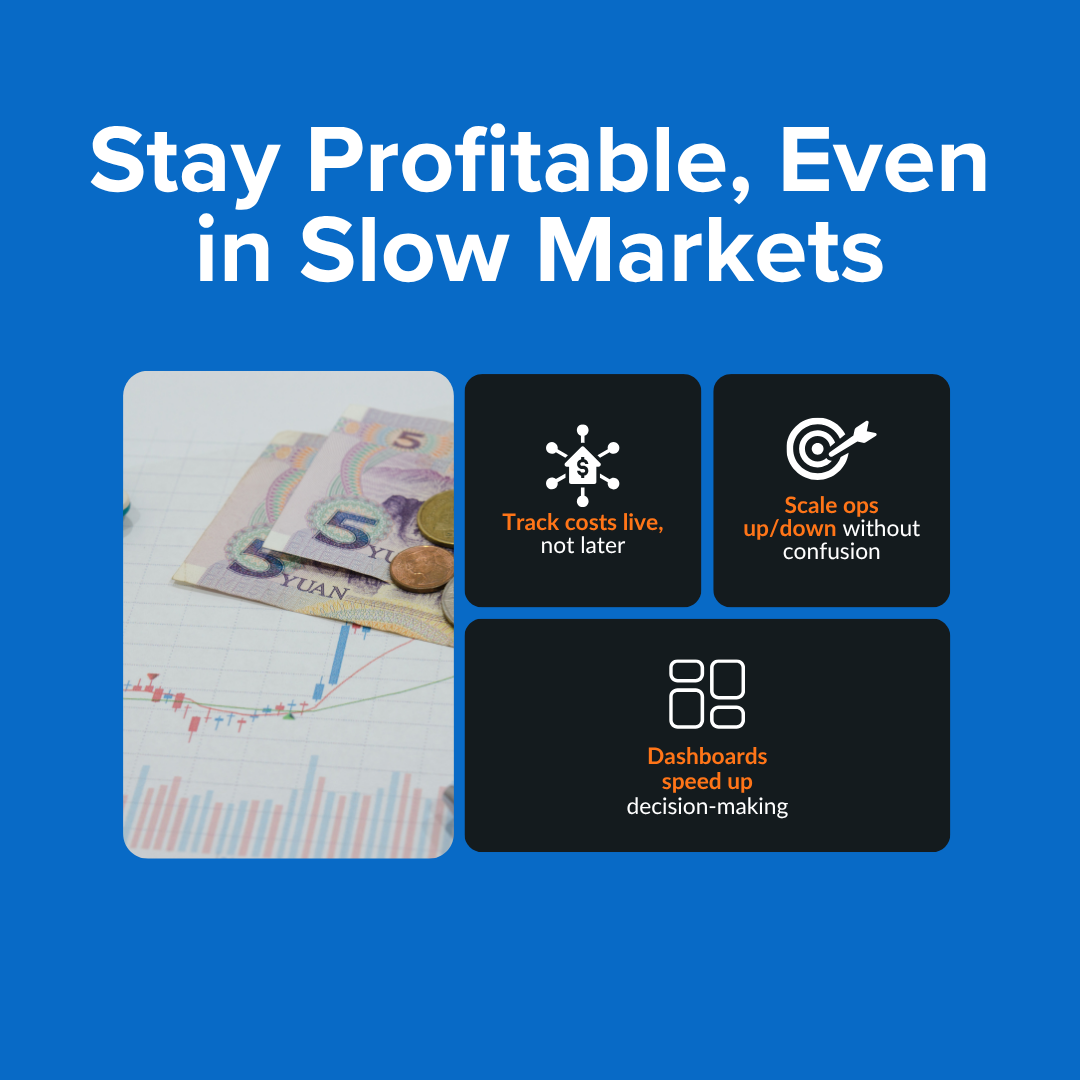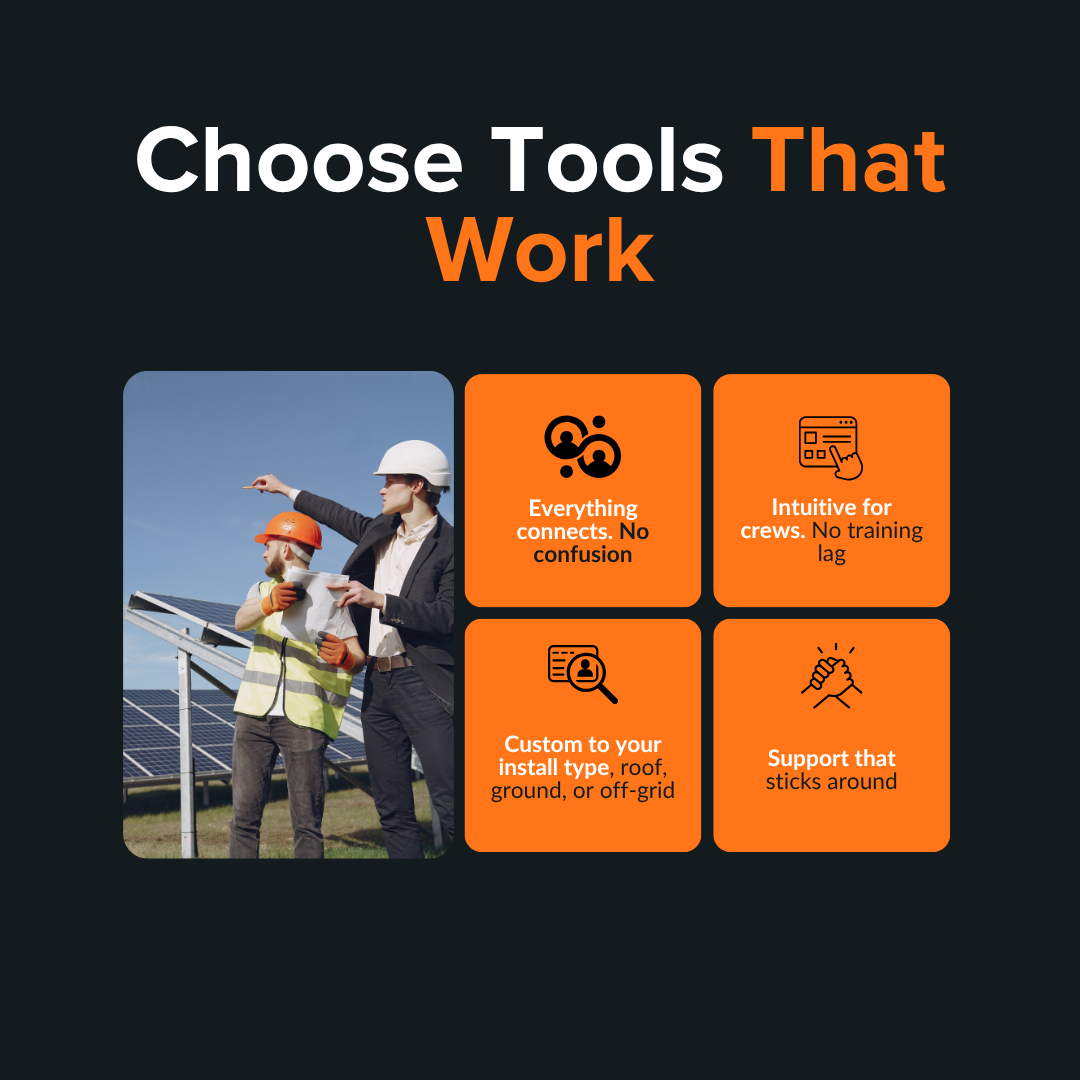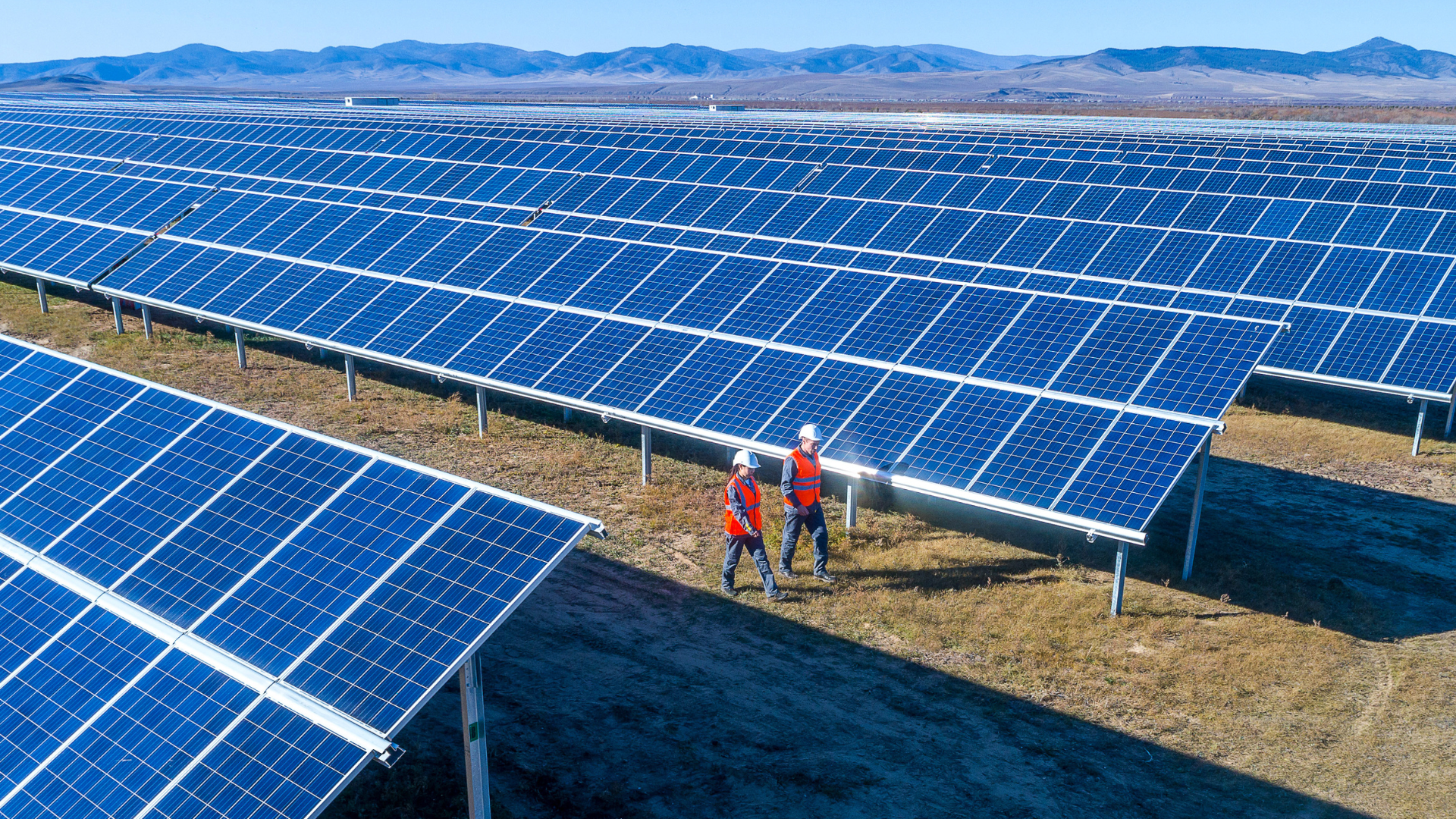June 26, 2025
Audio Overview: Listen & Learn
Picture this: your solar business is mid-project when a tariff shifts, a shipment stalls, and two crew members call in sick. Sound familiar?
That’s not bad luck, it’s a stress test. And the firms that survive these punches aren’t the biggest or oldest. They’re
the most prepared.
Smart solar technology tools won’t fix the economy, but they will give you the control to keep solar panel installations on track, clients informed, and cash flow intact even when things go sideways.
Let’s explore how solar businesses are using tech to stay lean, fast, and financially resilient.
Top Tools to Strengthen Solar Business Resilience Through Technology
Resilience is all about having the right systems in place before challenges arise. Here, we take a closer look at the key solar technology tools that will help you stay current and confident in the ever-evolving solar industry.
Key Takeaways
- Know what’s happening, when it’s happening. Live dashboards help you identify issues before they result in financial losses.
- Everything should work together. Using too many apps separately leads to confusion. A connected software stack solves that.
- Move fast, close faster. Quick designs and instant proposals help you win the deal before your competitor even finishes the visit.
- Do more with less. Smart scheduling and mobile tools help a small team get more jobs done.
- Sunbase keeps it simple. One login, everything in one place. No copy-paste issues.
Why Solar Projects Need a Resilience Strategy

To survive in today’s unpredictable market, solar businesses need a resilient strategy, not just good intentions and a desire to increase profits.
That starts with being prepared. The section below discusses why having proactive systems and the right technology is essential for staying afloat in the ever-changing solar market.
1. Market Volatility and Policy Changes
The solar industry is growing rapidly, and with that comes the constant changes that your teams need to stay up-to-date with.
For instance, local and national policies significantly influence the development of solar power systems. Tax
incentives can vanish between phone calls. Net metering rules are being rewritten while PV systems are still in the design phase.
Contractors without real-time tracking tools risk quoting outdated rates or worse, losing the project to a more agile competitor.
2. Supply Chain Disruptions
Solar installation is a process that can be disrupted by a single component missing.
For instance, a single missing inverter can stall a solar system installation indefinitely.
We saw this during the COVID pandemic, and the ripple effects haven’t disappeared. Global trade routes are fragile. Raw materials, especially those used in PV systems, are often delayed or redirected.
Therefore, in such uncertain times, solar firms using predictive inventory tools can reroute more quickly, track vendor performance, and avoid overstocking on components they won’t use.
3. Labor Shortages and Rising Costs
The solar workforce isn’t growing fast enough to meet demand.
Whether you're installing residential solar panels or scaling commercial PV systems, technician shortages and rising wages are eating into timelines and profits. Scheduling headaches only worsen an existing situation.
The only solution, thus, is to automate or get left behind.
8 Solar Technology Tools Every Contractor Should Be Using

What's your dream for your solar business? A job site where every panel performs at peak power, technicians have real-time data in hand, and delays are rare is not a daydream. This can be your reality.
Here are the eight solar technology tools that help solar professionals deliver high performance and reliability, one PV system at a time.
1. Project Management Software
Examples: Sunbase
Solar installations often involve multiple timelines, crew assignments, and compliance checks. Digital project platforms bring all the data into one dashboard.
With project management software, you can:
- Track every module’s location, voltage, and installation date.
- Prepare equipment, take required measurements, and perform safety checks.
- Simplify solar panel installation workflows and material orders.
With everyone having access to the essential data in a single place, delays are reduced, and your profit? That
increases.
2. Solar Design and Proposal Tools
Examples: Sunbase, Aurora Solar
The answer to your client's question, "How much electricity will a system produce?" can be simply answered if you use solar design and proposal tools.
These tools simulate sunlight hitting different roof angles, module types, and local grid conditions. Thus providing highly accurate energy production estimates and financial returns.
With Solar Design and Proposal Tools, you can:
- Generate 3D layouts of solar panels and PV systems.
- Optimize pitch, tilt, and shading to maximize energy yields.
- Generate professional solar power systems proposals with ROI numbers.
Clients appreciate knowing exactly how much electricity their rooftop array will produce and when it pays off,
and you do exactly that to keep your clients happy.
For further insight, see: Why Every Solar Business Should Use a Proposal Tool (Even if You Rely on Excel)
3. Customer Relationship Management Platforms
Examples: Sunbase, Salesforce, HubSpot
Tracking leads, follow-ups, and maintenance schedules is tedious without automation.
That's where a CRM can help you:
- Monitor prospects through the quote, install, and servicing stages.
- Automate reminders (e.g., for inspections or cleaning).
- Keep audit trails of every email, call, and document.
This means no lead slips through the cracks, and every customer feels supported.
Also check out: Key Features to Consider in Solar CRM Software for Your Business
4. Inventory & Supply Chain Management Tools
Think of this as the brain behind your warehouse. These tools track temperature, delivery ETAs, and stock levels.
With Inventory & Supply Chain Management Tools, you can:
- Get an alert before the panel overstock or inverter shortage occurs.
- Compare vendor performance and lead times.
- Automatically reorder parts based on usage trends.
Reliable inventory means installers always arrive with the right gear, eliminating the need for improvising mid-job.
5. Financial Forecasting & Business Analytics Software
Understanding margins across multiple solar projects is crucial for scaling.
Analytics platforms offer:
- Cash-flow forecasts tied to solar project milestones.
- Comparative cost analysis across equipment types.
- Projections of future energy, returns, and efficiency gains.
You’ll know which solar power systems generate the best returns and where cutting back is a smart move.
6. Mobile Field Service Apps
A tablet on-site beats clipboards every time. These apps let solar technicians:
- Capture voltage, current, and preventive maintenance checks.
- Record photos of panel alignment, roof penetration, or safety issues.
- Upload real-time field notes that sync instantly with back-office systems.
This improves accuracy, reduces paperwork, and ensures defect-prone PV systems are caught early.
7. AI-Driven Scheduling & Resource Allocation
When Labor is tight, schedules change daily. AI-powered schedulers optimize crew assignments, factoring in:
- Technician certifications, proximity, and availability.
- Urgent service calls vs. standard solar panel installation jobs.
- Weather disruptions. They minimize idle time, maximize productivity, and help ensure every crew has the right tools, even before they hit the roof.
8. Automated Customer Portals & Support Systems
Transparency builds trust. Automated Customer Portals & Support Systems let customers track their own solar system’s performance using portals with live data:
- Energy production graphs (daily kWh, monthly, yearly).
- Alerts for underperformance or safety issues.
- Scheduling tools for maintenance or system cleaning.
It’s one thing to install solar panels, another to prove they’re producing clean energy every day. This tool strengthens the relationship beyond the sale.
If you want all these tools plus support. Head over to Sunbase and book your demo today!
Sunbase combines CRM, design, field apps, automation, and analytics into a single platform designed specifically for solar professionals.
It’s everything you need to manage solar projects, boost system performance, and grow with confidence.
Features and their differences as seen in Manual Estimating and Software Estimating.
| Feature | Manual Estimating | Software Estimating |
|---|---|---|
| Accuracy of energy estimates | Approximate | Precision based on sunlight modeling |
| Quote turnaround time | Days to prepare | Minutes with templates and ROI calcs |
| Handling design changes | Costly rework | Fast updates with recalculated metrics, and ensure the panel's optimal performance |
| Client trust | Depends on trust in the contractor | Backed by clear data and heatmap visuals |
How Technology Helps Solar Companies Weather Economic Downturns

The solar industry isn’t recession-proof. Rising interest rates, supply chain volatility, and shifting policy incentives can all erode profit margins.
However, with the right solar technology tools, solar businesses can reduce costs, enhance visibility, and respond more quickly than their competitors when the market fluctuates.
1. Cost Tracking and Real-Time Budget Adjustments
Imagine knowing exactly where your money’s going before you’re hit with the monthly report.
With digital tools, solar teams can track expenses as they occur, including materials, labor, and equipment. You can see what’s being spent, where, and by whom, without waiting for someone to crunch numbers later.
And if something changes? The system updates your cash flow and profit margins in real-time, so you’re not stretching your budget blindly when things slow down.
No guesswork. A clearer picture to make smarter decisions.
2. Scaling Up or Down Without Losing Control
Growth is great until you overhire or overbuy.
A robust tech stack empowers solar companies to scale their operations up or down without any issues.
- More solar projects coming in? Crews are assigned automatically based on availability and certifications. No manual planning needed.
- Hitting a slow patch? You can pause extra orders and redirect your team to where they’re needed most.
Whether it’s a home install or a large commercial PV system, digital tools help you match your workload to the market, so you’re not spending money based on hope.
3. Faster Decision-Making With Live Dashboards
The old way? Sorting through emails, PDFs, and spreadsheets that are all over the place.
The better way? Real-time dashboards showing everything from energy production to team availability to inventory levels.
When every stakeholder from field tech to project manager can view the same live data, decisions don’t get delayed by confusion. You act faster, correct issues sooner, and keep the entire installation and maintenance process aligned.
In a downturn, speed is a powerful asset. And nothing accelerates confidence like clean, centralized data.
Building a Resilient Tech Stack: What to Look For

Not all solar technology tools are built the same, and some can hinder your progress if they’re outdated or
burdensome to adopt.
Choosing the right tools is about flexibility, reliability, and how well each piece fits into your solar workflow.
Here’s what to look for when investing in your solar tech stack:
1. Seamless Integration Across Systems
Your CRM shouldn’t be off doing its own thing, and neither should your solar design tools, inventory system, or mobile field apps.
The best platforms connect everything, so your sales, ops, and field teams are all working from the same info.
When everyone can see updates in real-time, you reduce rework, avoid miscommunications, and make quicker, smarter decisions.
2. User-Friendly Design
If your crew can’t figure it out on day one, it’s probably not worth it.
Choose tools with clean interfaces, mobile accessibility, and intuitive workflows. That’s especially important for
field apps used during solar panel installations or temperature measurements on rooftops.
The best tech doesn’t need a manual. It just works.
3. Customization for Your Specific Needs
Residential vs commercial? Rooftop vs ground-mount? Grid-tied vs off-grid?
Your solar power systems aren’t one-size-fits-all. Your tools shouldn’t be either.
Opt for platforms that allow you to customize quotes, workflows, performance reports, and maintenance schedules according to the unique needs of each project and client.
This level of flexibility helps you deliver the precision, quality, and customer experience that sets your solar business apart.
4. Strong Support & Long-Term Reliability
Glitches happen. What matters is how fast you get help.
Choose reputable brands with responsive customer service, regular updates, and a track record of supporting solar companies long after onboarding.
When you invest in a tool, you're also investing in the team behind it. Make sure they’ve got your back.
Also read: A step-by-step guide to integrating solar software into your workflow.
What makes Sunbase the all-in-one tool you've been looking for?

Sunbase is an all-in-one operating system designed specifically for the solar industry.
From lead management and proposal design to project tracking, field coordination, and customer support, it helps solar companies streamline every part of the installation and maintenance journey.
Here’s what makes Sunbase stand out:
- Integrated CRM: Track leads, automate follow-ups, and close deals faster.
- Advanced Proposal Builder: Generate professional designs and accurate quotes within minutes.
- Smart Scheduling and Crew Management: Utilize AI-powered tools to assign jobs and prevent overlaps efficiently.
- Inventory and Workflow Tracking: Stay on top of your materials and project milestones in real-time.
- Mobile-Friendly Interface: Your field team can update tasks, upload images, and sync notes directly from the job site.
Fast-growing solar firms across the U.S. utilize it to reduce costs, enhance team productivity, and deliver clean energy with precision and consistency. Whether you're scaling operations or navigating a downturn, Sunbase provides the essential tools to stay ahead.
Overview
Smart solar businesses don’t wait for the next crisis to adapt.
They build resilience before it’s needed.
By integrating modern solar technology tools, such as CRMs, mobile apps, design platforms, and forecasting software, you can track performance, control costs, and continue to grow even when the market dips.
Stay Competitive with Smarter Tech
Sunbase brings together the full suite: CRM, scheduling, quoting, analytics, and more into one easy-to-use platform tailored for solar professionals.
Book your demo today and take the first step toward a more resilient, scalable, and profitable solar business.
FAQs
Q1. What are the most essential tools for solar companies in 2025?
Project management software, CRM systems, solar design platforms, field service apps, and analytics tools are critical for handling everything from solar panel installation to long-term system performance tracking.
Q2. How do solar tools improve system efficiency?
By providing real-time data on factors such as electrical current, temperature, and shading, these tools enable solar technicians to make adjustments that enhance energy production and prolong equipment life.
Q3. Can small solar companies afford these tools?
Yes, many platforms offer scalable pricing, and reduced delays often offset the cost, leading to improved quoting accuracy and increased productivity.
I agree to receive marketing messaging from Sunbase at the phone number provided above. I understand data rates will apply, and can reply STOP to OPT OUT.







